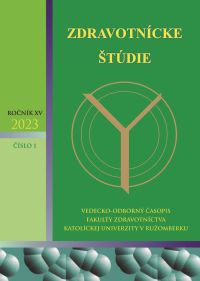Manažment ošetrovateľskej starostlivosti o pacienta po endoprotézach
Nursingcare Management Care of the Patient after Endoprostheses
Author(s): Richard Bárta, Mária PopovičováSubject(s): Health and medicine and law
Published by: VERBUM - vydavateľstvo Katolíckej univerzity v Ružomberku
Keywords: Management; Nursing care; Hip joint; Endoprosthesis; Patient
Summary/Abstract: Introduction: We present a comprehensive view of the nursing management of patients after endoprostheses. The paper also discusses the information given on compensatory devices and their use in practice by patients after implanted endoprostheses. Attention is focused on exploring the subjective perception of the patient’s health status after endoprosthesis and the provision of information prior to elective surgery. In the last area examined, the thesis investigates the relationship between gender, occupation and associated diseases, which as external factors may influence the implantation of an endoprosthesis. In the empirical part of the thesis, the research problem was set to find out “How the implantation of an endoprosthesis can affect the perceptibility of the patient’s health status.” In order to achieve the main objective, we set individual subobjectives: To find out the difference in patient’s perceptibility before and after total knee/hip arthroplasty implantation; To determine whether patients are provided with sufficient information about treatment options, risks of surgery, medical, diagnostic and therapeutic procedures as well as potential risks and consequences associated with healthcare prior to elective hip/knee replacement surgery; Determine whether, when receiving healthcare, the healthcare facility informed the patient about the possibilities of providing and how to use compensatory devices that affect the patient‘s health after the surgery; Determine whether gender, comorbidities, and occupation are factors that may affect the implantation of an endoprosthesis. Methodology: In order to verify the hypotheses and fulfil the main objective, we used quantitative research methods (questionnaire). On the basis of the collected information, we have underlined the context of the analyzed areas, to obtain a comprehensive picture of the studied topic. In order to achieve the aim of the work, working hypotheses were established, for the processing of which chi-square test of goodness of fit was used to evaluate the statistical data. The result is a set of hypotheses, which are subsequently formulated into concrete suggestions and recommendations. The respondent pool consisted of patients after hip/knee implantation, of different ages and gender. A total of 120 questionnaires were distributed during the research, namely 60 questionnaires at the Department of Trauma Surgery at Rastislavova No. 43 in Košice and 60 questionnaires at the Department of Orthopaedics and Traumatology of the Musculoskeletal System at the SNP Class 1 of the UNLP in Košice. The total number of respondents who participated in our research was 112 (93.33%) respondents, while the return rate of questionnaires at the Department of Trauma Surgery was 58 respondents (52%) and at the Department of Orthopaedics and Traumatology of the Musculoskeletal System was 54 respondents (48%). Conclusion: Following the set objectives, the paper brings answers to the issue of patient awareness and the connection between the above mentioned external factors in relation to the implantation of the endoprosthesis. The proposed recommendations for practice are intended to make the nursing care of the patient after joint arthroplasty more effective.
Journal: Zdravotnícke štúdie
- Issue Year: XV/2023
- Issue No: 1
- Page Range: 67-72
- Page Count: 6
- Language: Slovak

